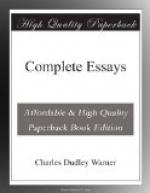In his account of the Romantic School in Germany, Heine says, “In the breast of a nation’s authors there always lies the image of its future, and the critic who, with a knife of sufficient keenness, dissects a new poet can easily prophesy, as from the entrails of a sacrificial animal, what shape matters will assume in Germany.” Now if all the poets and novelists of England and America today were cut up into little pieces (and we might sacrifice a few for the sake of the experiment), there is no inspecting augur who could divine therefrom our literary future. The diverse indications would puzzle the most acute dissector. Lost in the variety, the multiplicity of minute details, the refinements of analysis and introspection, he would miss any leading indications. For with all its variety, it seems to me that one characteristic of recent fiction is its narrowness—narrowness of vision and of treatment. It deals with lives rather than with life. Lacking ideality, it fails of broad perception. We are accustomed to think that with the advent of the genuine novel of society, in the first part of this century, a great step forward was taken in fiction. And so there was. If the artist did not use a big canvas, he adopted a broad treatment. But the tendency now is to push analysis of individual peculiarities to an extreme, and to substitute a study of traits for a representation of human life.
It scarcely need be said that it is not multitude of figures on a literary canvas that secures breadth of treatment. The novel may be narrow, though it swarms with a hundred personages. It may be as wide as life, as high as imagination can lift itself; it may image to us a whole social state, though it pats in motion no more persons than we made the acquaintance of in one of the romances of Hawthorne. Consider for a moment how Thackeray produced his marvelous results. We follow with him, in one of his novels of society, the fortunes of a very few people. They are so vividly portrayed that we are convinced the author must have known them in that great world with which he was so familiar; we should not be surprised to meet any of them in the streets of London. When we visit the Charterhouse School, and see the old forms where the boys sat nearly a century ago,




